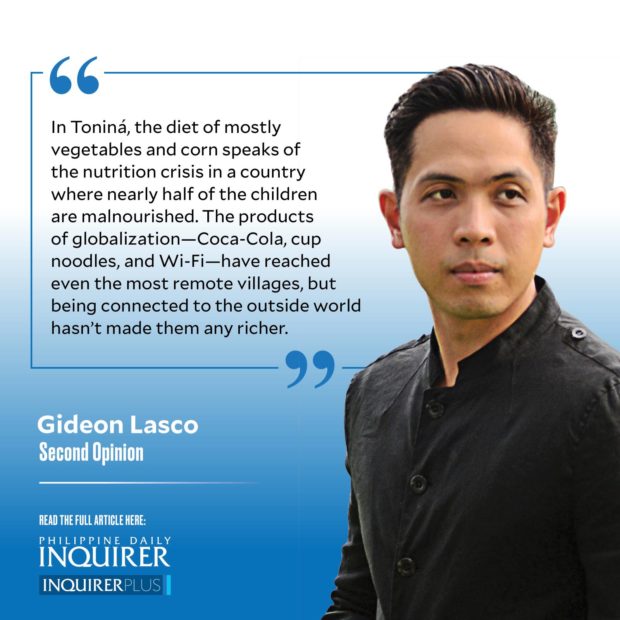San Cristóbal de las Casas—As the colectivo cruises along the roads that snake through the coffee plantations of Chiapas, Mexico, a few kilometers away from Guatemala, I cannot help but reflect on life on the border of two countries.
I had just finished a two-day hike up Volcán Tacaná, at 4,093 meters the tenth highest mountain in Mexico and the second highest in Guatemala. I was joined by Dr. Terence Kua, my schoolmate at the UP College of Medicine and former doctor to the barrio.
During the trek across pine and mossy forests, we ended up crossing the border several times, firstly from the frontier town of Talquian, Mexico to the village of Toniná, Guatemala, where we spent the night in Casa Yolanda, a family-run homestay.
Some of the challenges of living on the border can seem trivial—for instance, having two different time zones. “Which time do you use?” I asked our guide Abi Bartolon, who lives in Toniná but fetched us from Talquian. “We use both, but specify what time we’re using,” he replied. Later, as we had dinner of homemade tortillas, boiled carrots, and a tiny portion of chorizo, he reminded us that we had to start the trek very early the next day, alas dos de Guatemala.
But there are deeper, structural issues that have to do with the marginality of a region that was historically home to the Maya civilization. In Toniná, for instance, the diet of mostly vegetables and corn speaks of the nutrition crisis in a country where nearly half of the children are malnourished. The products of globalization—Coca-Cola, cup noodles, and Wi-Fi—have reached even the most remote villages, but being connected to the outside world hasn’t made them any richer.
Arguably, it is the opposite that has transpired. As the anthropologist Emily Yates-Doerr wrote in SAPIENS: “Trade liberalization driven by … structural adjustment policies had reduced barriers to imports from the U.S. As corn from the U.S. flowed into Guatemala, it diminished the value of locally grown crops, forcing countless rural farmers into debt or financial ruin. Farmers could no longer earn enough from their crops to survive.”
Meanwhile, although Mexico is much larger and richer than Guatemala, the state of Chiapas is the country’s poorest, with indigenous peoples faring even worse. Their ancestors may have built a flourishing civilization still evidenced by the majestic, tourist-drawing ruins of Palenque and Chichén Itzá, but they themselves continue to suffer from what Pope Francis during his 2016 visit here in San Cris termed “systemic and organized” exclusion from Mexican society.
Coffee—the crop which the region is known for—has barely made a difference. The specialty cafés in this tourist- and expat-friendly city may celebrate the nuances and notes of locally produced coffee, but the coffee growers and harvesters themselves are mostly underpaid, and often at the mercy of various factors, from climate and coffee plagues to currency fluctuations and global coffee prices.
Such economic conditions are drivers of illegal migration to the US, but they are not the only ones. Yates-Doerr, among others, implicates a “genocide against indigenous peoples,” enabled by a “culture of impunity”: one which doubtless exists not just in Guatemala but in countries in the region.
Which is why today, migration is part of everyday life, both for those who left and those they left behind. “Look at those large houses,” as one local pointed to me as we passed through an otherwise barren landscape. “They are built from the money of those who made it [to the US].”
But not everyone manages to make it big—or even just make it. Two weeks ago, 53 migrants—at least 22 from Mexico and 19 from Guatemala—were found dead in a trailer in San Antonio, Texas: just one example of the dangers migrants face as they escape the dangers in their homeland.
—————-
All of the above issues seem distant from the mountain, and as we continued our hike the next day, even our guide allowed himself to be amazed by a beautiful sunrise that he had not expected during the season of rains. “It will be a blessed day,” he declared.
Hours later, at the rocky summit, we beheld the blue mountains of Guatemala, most prominently Volcán Tajumulco, the highest in Central America, from whose peak I first saw Volcán Tacaná years ago. Aby pointed to various places that lie in either country, but from over 4,000 meters above sea level, the land seemed one undivided whole, just as the Mayan lands once were before the colonial imposition of borders.
Which is perhaps why, when I asked him what he thinks the difference is between Guatemala and Mexico, his answer was quick and definitive:
“Nothing.”
—————-
glasco@inquirer.com.ph
